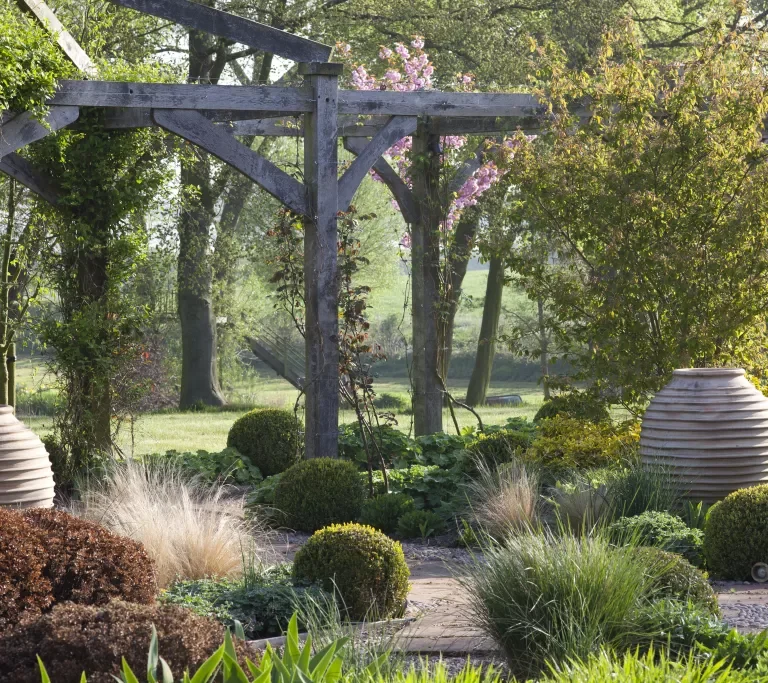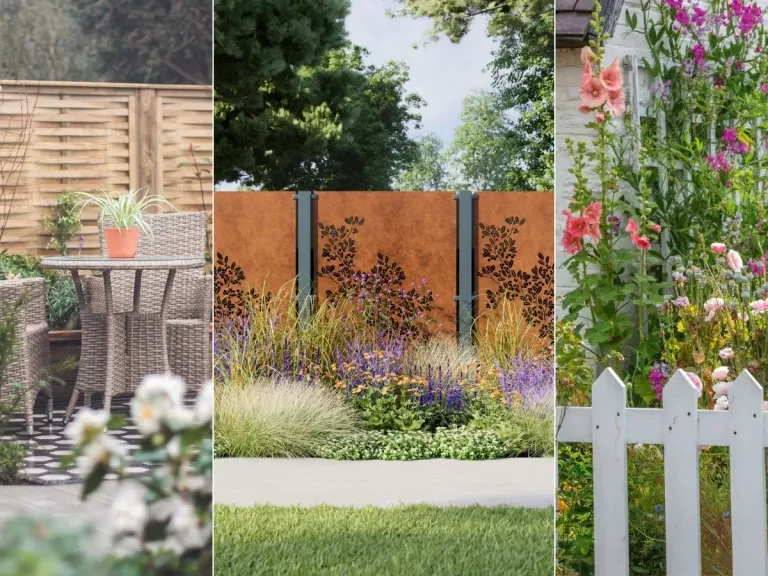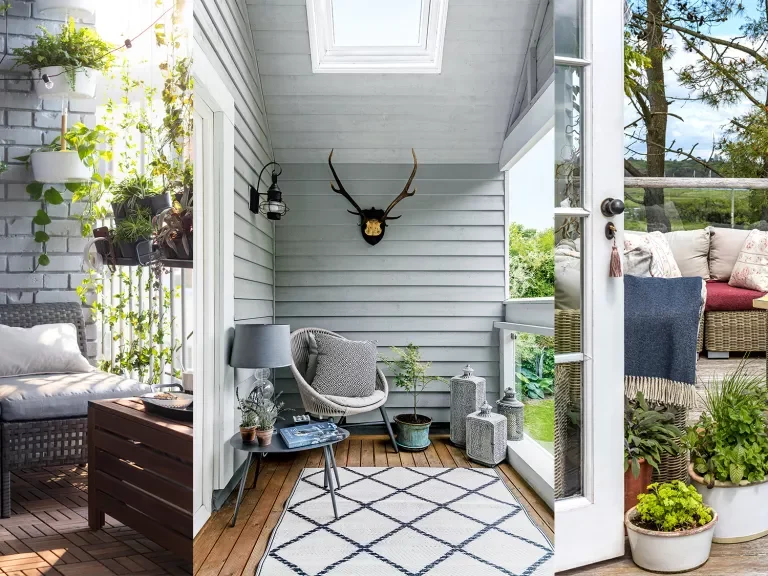Garden pond ideas – 10 beautiful backyard ponds
A pond in your garden will not only enhance your outside environment, but it will also provide a favourite spot for calm periods and quiet reflection. A pond is necessary to create a sensory garden because it is the finest spot to immerse yourself in nature.
The style of the pond you select will be influenced by the overall design of your yard. A modern reflection pool, frequently accompanied by a water blade or rill, can work nicely if you prefer sleek and contemporary. If you like more casual gardening, a natural pond would fit in well. A freestanding stone or concrete basin is an excellent choice for courtyard gardening.
Whatever style you choose, pond margins look great when bordered with lush and leafy plants, and this also helps to provide a rich home for wildlife. The more densely planted the pond, the more wildlife-friendly it will be. Sloping-sided ponds provide access for little species, while flora attract bees, butterflies, and dragonflies.
Water feature ideas are essential for garden pond ideas, and you’ll want to do it properly. Our inspired garden ideas and recommendations point the way.
1. OPT FOR A COOL AND CONTEMPORARY DESIGN

Modern ponds are at the top of everyone’s wish list regarding adding a soothing touch to the landscape, especially when matched with a tapestry of lush vegetation and pond plants. The reflections of the clouds and trees over the water give an instantly relaxing touch.
A pond can be easily incorporated into your garden design by filling a vast Corten steel basin with water and plants. The key to success is to keep things simple. This design has no pump, electricity, or water supply. Simple pools are ideal for incorporating a garden pond into your tiny garden ideas and design plans.
The lake is silent and reflective, creating a peaceful environment surrounded by lush green plants. Corten steel’s copper tones contrast with the green foliage of the beautiful grass Hakonechloa macra surrounding it. This, combined with a spreading mat of water lilies, offers a rich texture and colour. Choose a water lily suitable for tiny ponds, such as the dwarf Nymphaea Aurora.
2. ENHANCE YOUR POND WITH A STEPPING STONE PATH
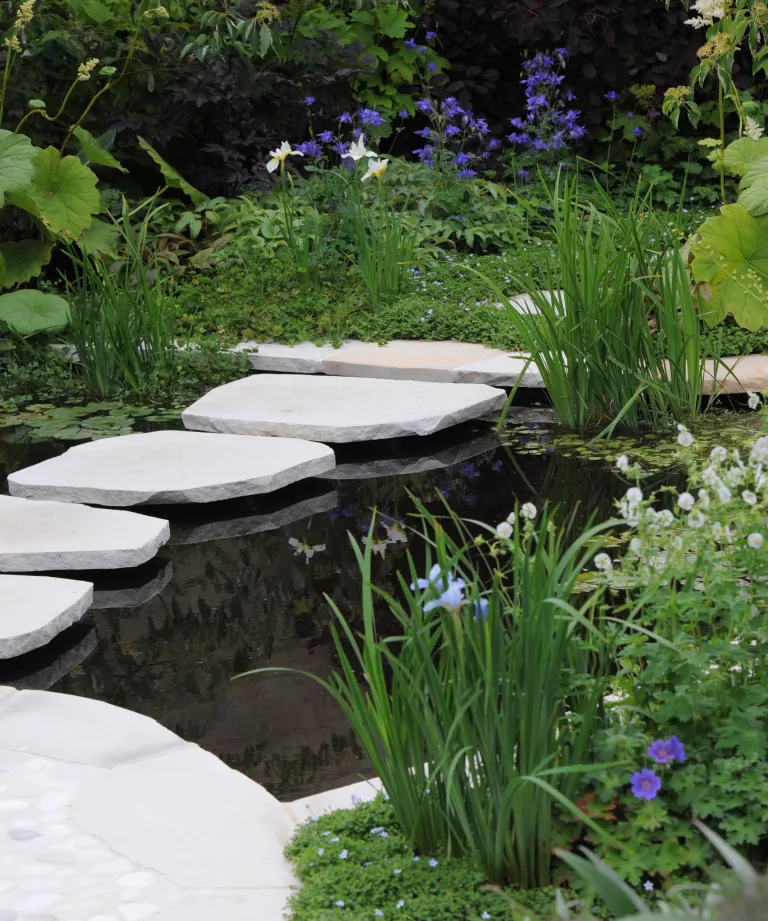
One of the garden pond ideas that adds to the enchanting experience is to incorporate a lovely stepping stone walkway over. Being one with the pond is incredibly enticing and allows you to enjoy it up close and personal. Stepping stones can allow access to aquatic plants that may require maintenance.
Stepping stones must be steady, wide, and clear of the water. Granite, sandstone, and gneiss are all excellent choices for your design. You can also lay square natural stone slabs on a cast concrete base, depending on the garden style and surface of the pond bottom.
Incorporating suitable planting into your stepping-stone design will improve your overall experience. Planting along a pool can be made more relaxing by adding blue elements. The early summer blossoms of Iris sibirica ‘Perry’s Blue’ are a welcome splash of colour around water features and wet ponds in the yard. Iris laevigata is a blue-purple variation that also does well in the water’s edge of ponds.
Acorus calamus ‘Argenteostriatus,’ commonly called a sweet rush or sweet flag, is a tall, arching green plant. It prefers wet or swampy soils, making it an excellent candidate for the pond’s edge.
The large, rhubarb-like leaves of the herbaceous perennial gunnera manicata make a striking statement along the pond. Even a single plant of this species needs a considerable plot of land to thrive. Thus more extensive gardens are ideal.
3. CHOOSE A FREESTANDING SMOOTH BASIN STYLE
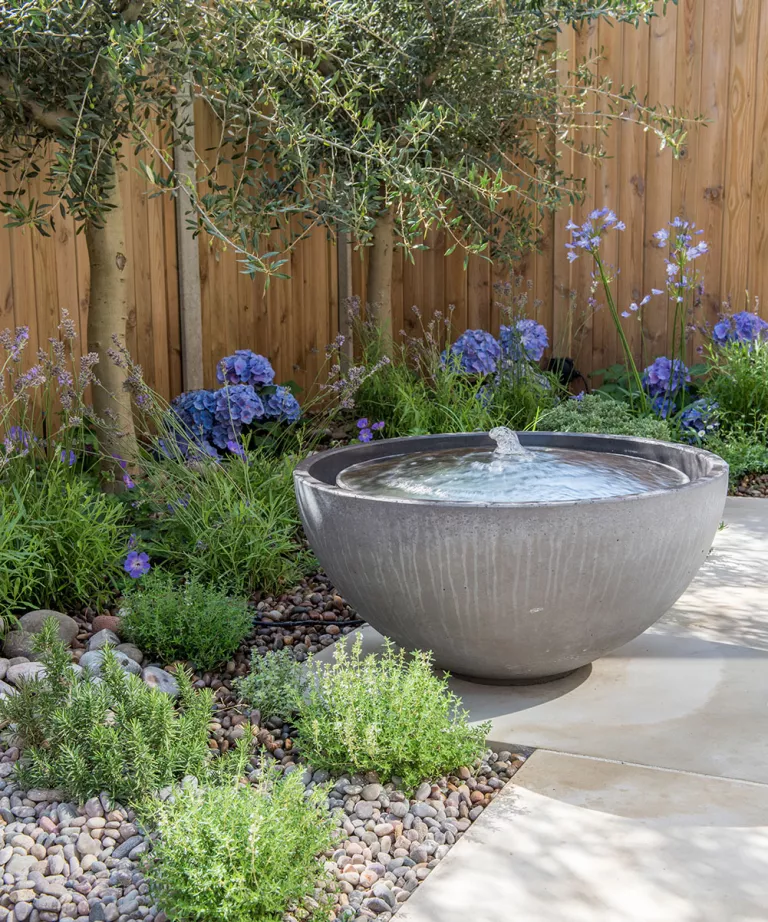
You may still enjoy the benefits of a water feature in locations like a paved courtyard or patio by installing a standalone “plug in and go” bowl design as one of your instant garden pond ideas.
Garden designer Catherine Clancy says, “Water features enrich any garden.” And best of all, they make a beautiful, calming noise. Reflecting light and plants, even a small water bowl, may make a big difference. These bowls do not need to be set up in any particular way. Put water in the bowl and connect it to the electrical water outside. After all, what could be simpler?
Water bowls are also a great addition to a Mediterranean garden design in a courtyard or beside a resting area in a sensory garden.
4. THINK OUTSIDE THE BOX WITH A MODERN STATEMENT
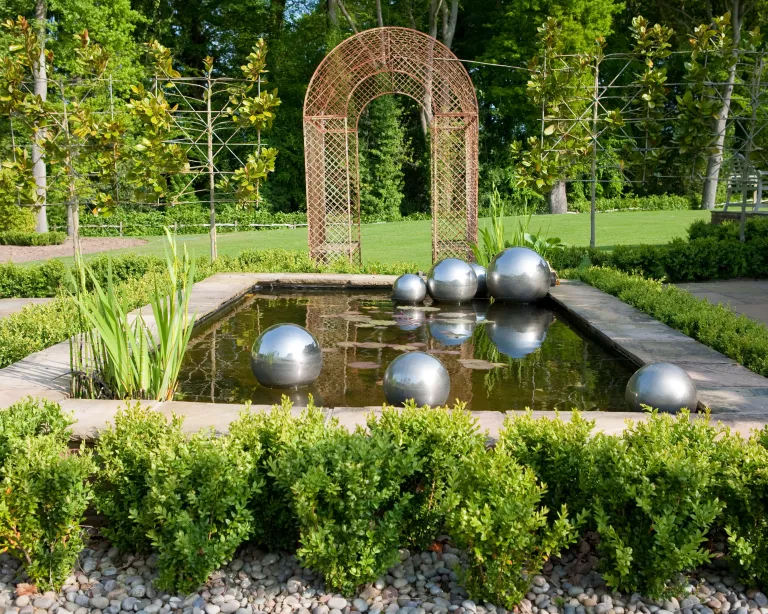
Add some visual appeal to your modern garden pond design by incorporating a piece of garden art or sculpture. Choose a set of gazing balls made of polished stainless steel to draw light to your pond. They are built to withstand the elements, so they may be placed in any pond, regardless of size or shape.
It’s a good idea to highlight these decorative globes in geometric pond design ideas with clever plantings, such as short hedges or clipped boxes, to emphasize the geometry of the pond without masking any decorative components you wish to highlight.
Nadia McCowan Hill, a style advisor at Wayfair, adds, “Accessories can have the same influence outside as they do inside.” You may turn your garden pond into a showpiece with a few decorative touches. Mirrored accents provide a light of tranquillity to a water feature while also providing a practical function, especially for ponds located in shaded areas of the garden.
5. PLAY WITH SHIMMERING REFLECTIONS

This contemporary pond design features a body of inky black water that sits quiet and reflects, creating a calming mood surrounded by rich green planting, featuring loose drifts of ornamental grasses contrasting with a tidy clipped box.
Dyeing pond water black with unique materials adds drama while preventing algae growth and simplifying pond upkeep. Non-toxic pond dyes prevent algae growth by blocking sunlight, thereby preventing photosynthesis. This can be achieved by planting submerged weeds in the pond or lake, preventing algae growth. People, pets, fish, and frogs are all able to safely enjoy the use of pond dyes.
Carex oshimensis ‘Evergold’, planted next to the pool, is reflected in the black water and adds a decorative touch. Evergreen and clean, ‘Evergold’ sedge has golden yellow and green striped leaves and thrives in wet environments.
6. CREATE A NATURAL WILDLIFE POND

Incorporating garden pond ideas has never been more timely with the current emphasis on biodiversity in garden design. Your garden will be instantly revitalized by introducing a pond, regardless of its shape, size, or depth, and it will soon be populated by wide wildlife of animals. Even the tiniest puddle of water can be used by amphibians like frogs, toads, and newts for reproduction.
According to Wildlife Trusts, “it is preferable for wildlife garden ideas if you situate the pond in a warm, sunny spot, as tadpoles, dragonflies, and plants with thrive in these conditions.” Add a “beach” with gentle slopes for wildlife to use as a ramp into and out of the water.
There is no need for water filters or pumps in a wildlife pond, and goldfish are not needed. Surround the pond with rocks, logs, and vegetation to provide shelter for pond plants. One of the best garden habitats for wildlife, pond margins combine aquatic and marginal planting techniques to create a unique environment.
7. INCLUDE A SOOTHING KOI POND

Add a koi pond if you want to have fish in your garden. Pick one with a slight rise so you can sit on the edge and take in the peace and quiet the fish will provide to your garden.
Beautiful koi, an ornamental fish with Japanese origins, may be found in a rainbow of colours, from blue and silver to orange and yellow, red and white, and everything in between. Learn the ropes with a small group of fish, and then, if you catch the collecting bug, you can continually expand your pond.
The fish are protected and can breathe easier thanks to the floating lily pads above them. Keep the koi from upsetting the lily plants by securing them in pots. If you live in a warm climate, you may keep the water in your koi pond cooler by surrounding it with trees and plants. The fish can take refuge in the cool shade when it’s boiling outside.
8. BLEND YOUR POND SEAMLESSLY INTO THE LANDSCAPE

Country gardens, with more room to work with, are perfect settings for the grander natural garden pond ideas that may be developed and seamlessly integrated into the surrounding landscape.
Creative Director Harriet Farlam of garden designers Farlam & Chandler says, “We often integrate ponds into gardens in a way that they become a feature that is not just fantastic for wildlife but also with the tremendous visual effect so that they feel essential to the character of the garden.”
To create a sensual and immersive atmosphere, “choose materials to edge the pond that relate to other garden sections” and “soften the periphery with ample planting that overhangs the water and flows in the breeze.”
9. ADD A SLEEK DESIGN DETAIL WITH A SCUPPER

Bowls for holding water that are works of art in their own right, especially those crafted from polished stone or concrete, are currently trending. It’s possible to add them to preexisting garden pond ideas or use them as a starting point for something new.
They add to the garden’s meditative atmosphere and serve as a focal point. They have sleek modern designs that laud the harmony between water and polished cast stone or concrete and pressed metal scuppers that make soothing tinkling water when activated.
Simple in concept, scuppers do their job. Water fills the bowl from a central hole in the base, forming a deep pool overflows into the scupper’s reflection channel.
These kinds of garden pond ideas are ideal for low-upkeep yards. Andy Kirman, a founder of Kirman Design, explains that “little self-contained elements are significantly easier to maintain.” Larger bodies of water are not as dramatic. Before making any major purchases, consider how much time you will spend maintaining your feature.
10. ENHANCE YOUR POND WITH SPECIAL EFFECTS

Those final touches can make all the difference. Framing a pond with lush tropical planting is an excellent way to give the impression of a tropical paradise. The royal fern, or Osmunda regalis as it’s known in the plant world, adds spectacular foliage and makes a striking border plant because of its tall, erect stature (it may reach heights of up to 6 feet, 2 meters).
For best results, sprinkle the fern leaves with water using a decorative fountain sprayer. In addition, it serves as the icing on the cake for creative garden pond ideas. To give your pond the edge in terms of unique effects, you may purchase jets that shoot up to 10 feet (3 meters) in height and can be set to rise and fall and be illuminated at night.
As a final negotiating ploy, you could always install some flamingo sculptures made out of metal.
HOW DEEP SHOULD A GARDEN POND BE?
What you plan to do with your pond will determine how deep the water should be. It would be best if you thought about the depth needs of wildlife, goldfish, koi, and pond plants.
A pond should be at least 2 feet (60 centimetres) deep to provide the best conditions for aquatic plants and fish. Too little depth in the water can cause it to evaporate in the summer and freeze in the winter. Add shelves for marginal plants to grow on at the water’s edge.
For the winter, pond fish need water to be at least 18 inches (45 centimetres) deep so they may burrow to the bottom. More profound than 4 feet (120 cm) is recommended for larger Japanese koi to survive the winter.
A wildlife pond without fish can have a much more shallow depth, 12 inches (30 centimetres), with vast, shallow regions for wildlife to climb in and out easily.
Water depth preferences of pond plants range widely, from just a few inches to many feet. Deep water is ideal for water lilies. However, marginal plants can survive with a planting depth of only 6-12 inches (15-30cm).
A design with various depths is recommended to accommodate the fish and plants found in the typical pond.
SHOULD A GARDEN POND BE IN SUN OR SHADE?
A pond can’t survive without healthy exposure to sunlight. Water plants almost universally require full sun to produce the most beautiful blooms. Water lilies will only grow leaves if their environment doesn’t get enough light.
Plants that produce oxygen need sunlight to do their job. These plants are crucial because they prevent the pond water from becoming stagnant and foster a healthy ecosystem for fish and plants.
The presence of shade is acceptable in a water feature that does not sustain wildlife, but it should be avoided in a pond that contains plants and fish. However, in really hot weather, fish can benefit from shade since it gives them an excellent place to hide.
HOW CAN I KEEP MY POND CLEAN?
Add some oxygenating plants or install some water filters to maintain a healthy pond (electric, carbon, plant-based). Make a strategy for their placement and power supply.
Pumps, either electric or solar-powered, may be needed to keep water circulating in ponds. You may need to avoid using chemicals to save and replace the water at regular intervals.
It would be best if you thought about how to make room for various aquatic and bog plants that are both beautiful and useful. Pick a pond with water, considering its visual appeal and aural one; a soothing trickle is preferable to a commode flush. Make sure there is no way a child or pet might get hurt in your pond. Slips and slides with gentle inclines make it possible to visit without fear of tripping over different kinds of wildlife.


